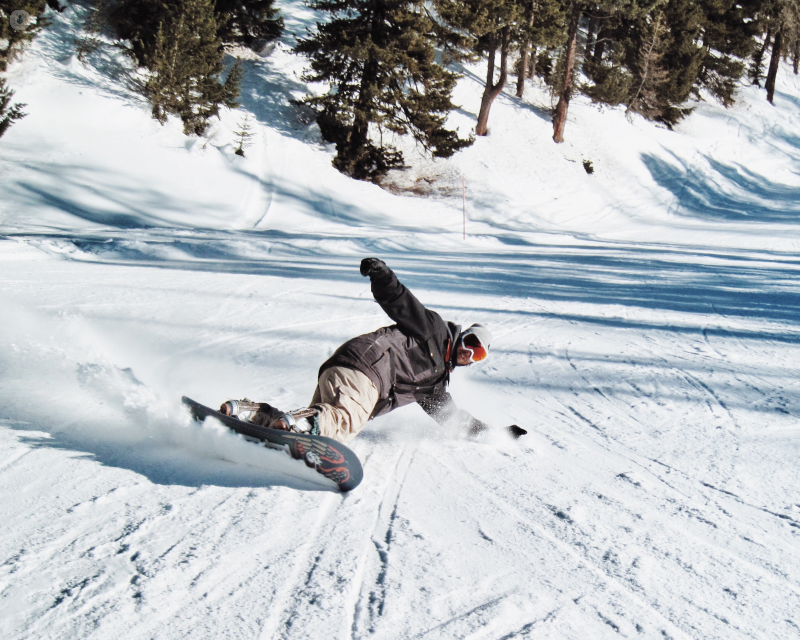New to snowboarding? Look after your hands and wrists
Escrito por:As we slide into the ski season, it’s the perfect time to start preparing yourself for the holidays ahead. Snowboarding is a wonderful sport, but if you’re a newbie, learning can be a bruising experience and coming home with a souvenir plaster cast is not what you want!
Consultant orthopaedic surgeon and hand and wrist expert, Miss Tanaya Sarkhel, based in Chertsey and Woking, highlights the most common wrist injuries suffered by snowboarders and how you can avoid them when you’re out on the slopes this winter.

What protective gear is needed for snowboarding?
When snowboarding, your feet are effectively tied together, meaning there are usually only two ways people fall: backwards and forwards. If you fall backwards, fortunately, your bum tends to cushion the blow. If you fall forward, however, your wrists are at risk of absorbing the impact.
Thankfully, our heads are firmly protected with a helmet, but wrist guards are often a frequently forgotten, but very effective, form of protection. You can hire them along with the rest of your gear, however, I have noticed that rental guards on offer are usually bulky, and though they do a brilliant job, they can be awkward to wear and make it difficult to keep your hands warm. My recommendation is to invest in your pair of own gloves with built-in protection before leaving the home.
What are some wrist injuries associated with snowboarding?
Falling on your open hands can put various structures in your wrist at risk of injury. It’s simply down to luck which one gives way under the forces applied.
Scaphoid bone
The bone which is at the highest risk of injury is the scaphoid bone, which is located under the base of the thumb. When we break our bones, it’s usually accompanied by pain, bruising, loss of movement and swelling. However, this little bone is sealed within the wrist joint, so all of these symptoms may actually improve over a week or two and you might find that some function returns as well. The curved, kidney bean shape of this bone means fractures can be difficult to pick up on initial X-rays and may only become obvious after a couple of weeks.
If you have had a fall and you are experiencing persistent pain at the base of your thumb - mainly when gripping things hard - repeat X-rays or a CT scan to help identify this as a possible injury. A broken scaphoid bone is one of the toughest bones in the body to heal and requires, at the very least, a plaster cast for around 8 to 12 weeks or a procedure is needed to screw and hold the break together to encourage healing.
Scapho-lunate ligament
Another structure at risk of injury is the scapho-lunate ligament, which links the scaphoid bone to its neighbour the lunate, one of eight carpal bones that form part of the wrist joint. Again, trauma to this part of the hand can settle quickly after a fall and sometimes it’s first thought of as just a sprain. But if you find that later down the line you are unable to push off that hand or struggle with a twist grip when opening a heavy door, then the reason might be due to a tear to this ligament. Unfortunately, the scapho-ligament isn’t usually able to heal by itself and if the two bones are left disconnected, they can drift apart with the potential to result in post-traumatic arthritis.
An MRI and, occasionally, keyhole surgery helps to check the ligament and plan what options might be effective in returning the wrist to normal function.
Ulnar collateral ligament (UCL)
Skier’s thumb is associated with a fall while holding the ski pole, but it can also be caused by falling over onto an open hand. It is a type of injury to the ulnar collateral ligament (UCL) of thumb and associated with bruising, pain and swelling. When we fall these ways, too much force is applied to the thumb which tears the ulnar collateral ligament.
Depending on the amount of force applied, there are situations where the UCL flips back on itself and is displaced from its regular position. If this happens, the injury will be unable to heal by itself, or even with a splint, and an ultrasound will be needed to diagnose this condition. It is known medically as a Stener lesion and requires surgery to straighten things out, reattach the ligament and restore your pinch grasp strength. If there is no Stener lesion identified, then a plaster cast will be fitted to support the healing process.
Reducing your risk of injury by wearing the correct protective gear, can allow you to enjoy the snow without problems and keep on the slopes for longer. If you’ve had a fall and your wrists and hands don’t feel quite right, it’s important to check things out with a specialist and support your rehabilitation.
Miss Tanaya Sarkhel sees patients at the Surrey Orthopaedic Clinic in Chertsey. To book an appointment, visit her Top Doctors profile today.


